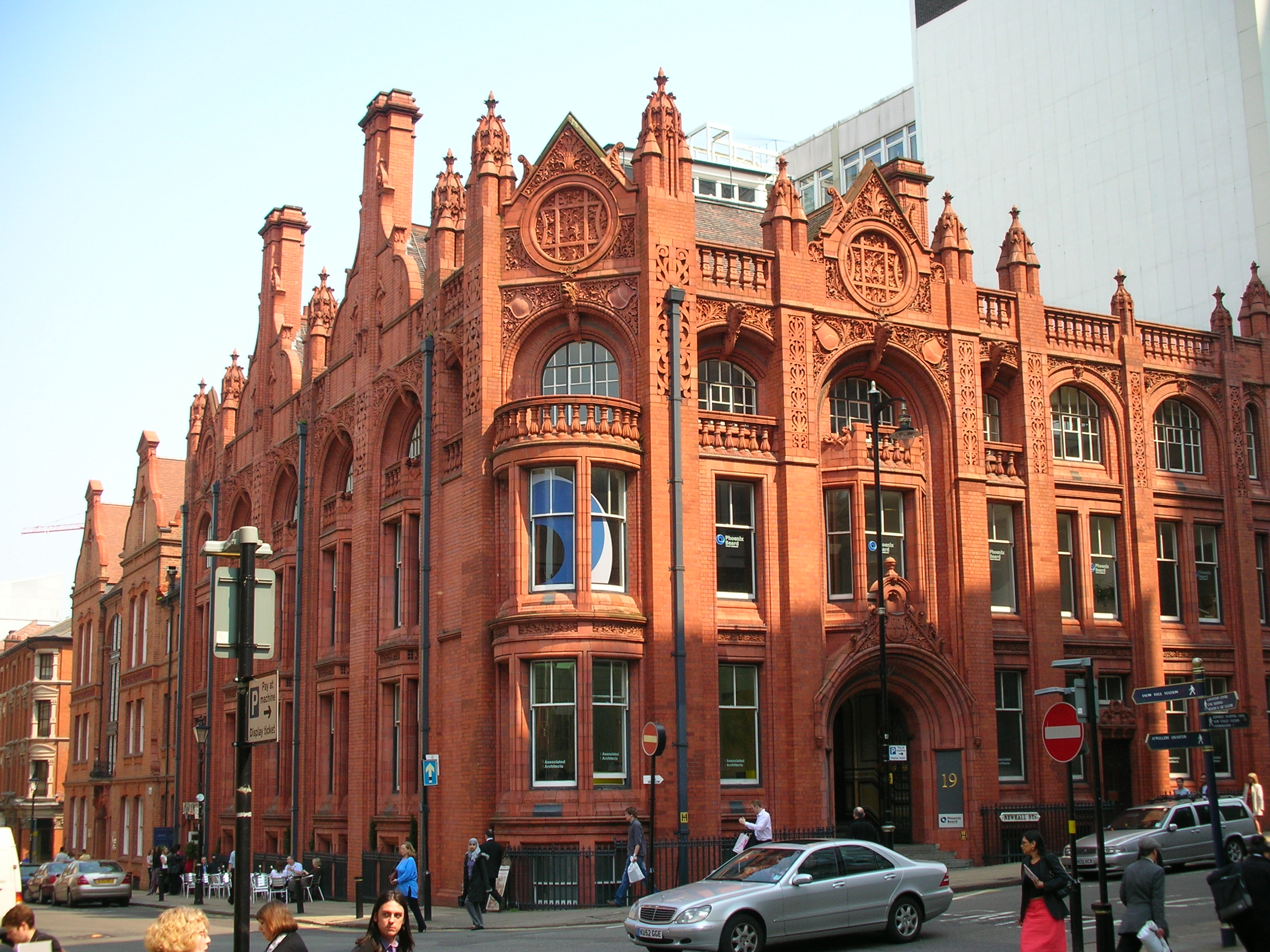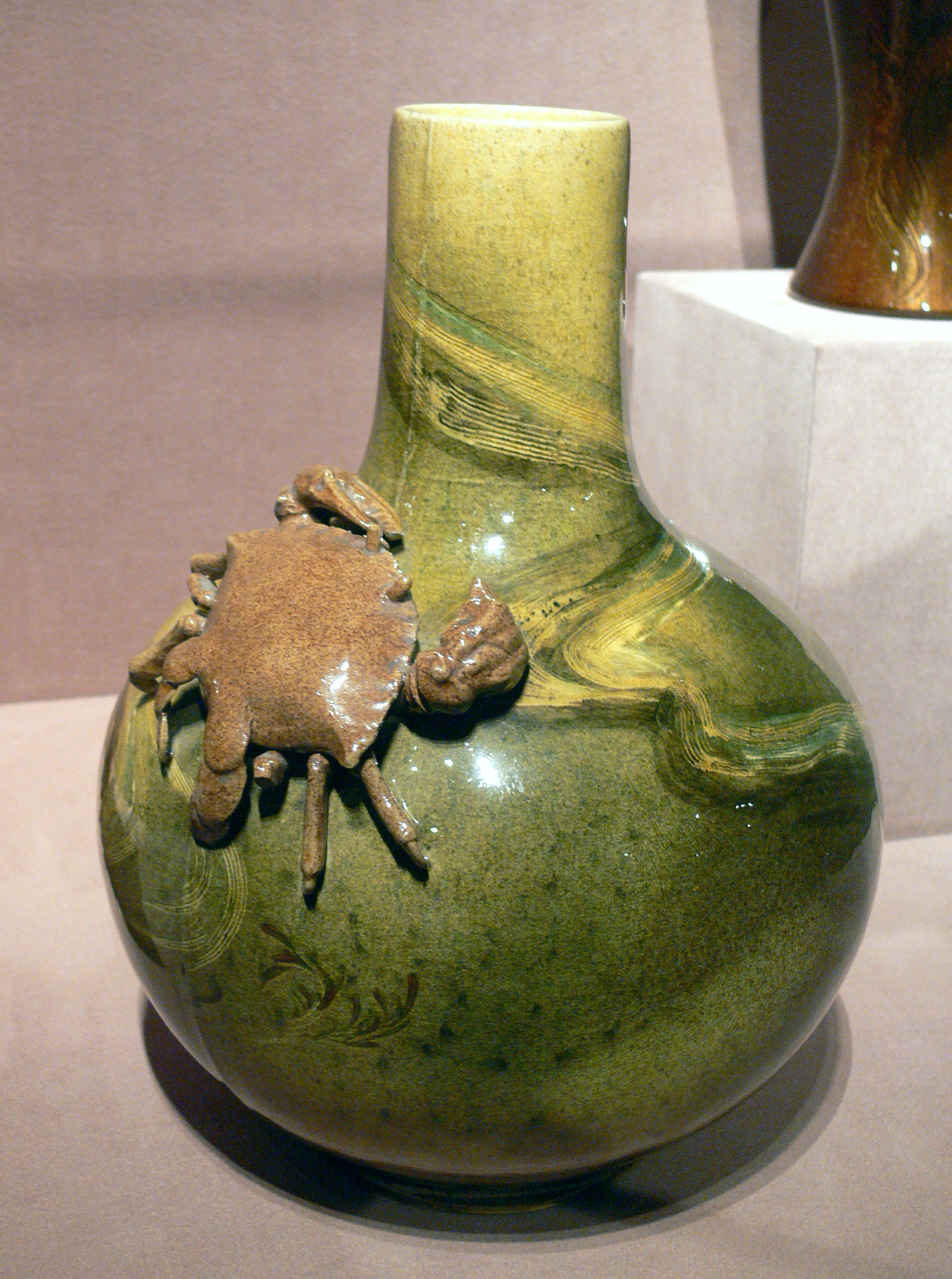|
Teco Pottery
Teco Pottery (pronounced TĒĒ - CŌ) was established, from the American Terra Cotta Tile and Ceramic Company, in Terra Cotta, Illinois by William Day Gates in 1881.ta. Wares and history The American Terracotta Tile and Ceramic Company was founded in 1881; originally as Spring Valley Tile Works; in Terra Cotta, Illinois, between Crystal Lake, Illinois and McHenry, Illinois near Chicago by William Day Gates. The American Terracotta Tile and Ceramic Company became the country's first manufacturer of architectural terracotta in 1889. Their production consisted of drain tile, brick, chimney tops, finials, urns, and other economically fireproof building materials. Gates used the facilities to experiment with clays and Ceramic glaze, glazes in an effort to design a line of American art pottery, art pottery. Gates was successful with his experimentation which led to the introduction of Teco Pottery. Teco pottery shapes derived from line and color rather than elaborate decoration. The ... [...More Info...] [...Related Items...] OR: [Wikipedia] [Google] [Baidu] |
Terra Cotta, Illinois
Terra Cotta is an Unincorporated area#United States, unincorporated community in McHenry County, Illinois, McHenry County, in the U.S. state of Illinois. History A post office called Terra Cotta was established in 1886, and remained in operation until it was discontinued in 1927. The community was named after a local terracotta pottery works. References Unincorporated communities in McHenry County, Illinois Unincorporated communities in Illinois {{McHenryCountyIL-geo-stub ... [...More Info...] [...Related Items...] OR: [Wikipedia] [Google] [Baidu] |
Vase MET ADA5234
A vase ( or ) is an open container. It can be made from a number of materials, such as ceramics, glass, non-rusting metals, such as aluminium, brass, bronze, or stainless steel. Even wood has been used to make vases, either by using tree species that naturally resist rot, such as teak, or by applying a protective coating to conventional wood or plastic. Vases are often decorated, and they are often used to hold cut flowers. Vases come in different sizes to support whatever flower is being held or kept in place. Vases generally share a similar shape. The foot or the base may be bulbous, flat, carinate, or another shape. The body forms the main portion of the piece. Some vases have a shoulder, where the body curves inward, a neck, which gives height, and a lip, where the vase flares back out at the top. Some vases are also given handles. Various styles and types of vases have been developed around the world in different time periods, such as Chinese ceramics and Native American ... [...More Info...] [...Related Items...] OR: [Wikipedia] [Google] [Baidu] |
Crystal Lake, Illinois
Crystal Lake is a city in McHenry County, Illinois, United States. Named after a lake southwest of the city's downtown, Crystal Lake is northwest of Chicago. The population was 40,269 as of the 2020 United States census, 2020 census. Crystal Lake is the most populous city in McHenry County, part of the Chicago metropolitan area. History Founding The City of Crystal Lake traces its origin to two communities which were established in the 1800s. Those communities were generally known as Nunda and Crystal Lake. In 1835, Ziba S. Beardsley had come to the shores of the lake and commented that the "waters were as clear as crystal", thereby giving the lake its name. Ziba Beardsley continued south to Naperville, Illinois, Naperville. In February 1836, the first white settlers, Beman and Polly Crandall and six of their ten children, came from New York State traveling to Crystal Lake in a covered wagon. Their original cabin was built in the vicinity of today's intersection of Virginia ... [...More Info...] [...Related Items...] OR: [Wikipedia] [Google] [Baidu] |
McHenry, Illinois
McHenry is a city in McHenry County, Illinois, United States. It is located about 46 miles northwest of Chicago. Per the 2020 census, the population was 27,135. McHenry was at one time the county seat of McHenry County, which once included adjoining Lake County to the east. McHenry took its name from the county, which was named for Major William McHenry, a prominent US Army officer in the Black Hawk War. It rests at an elevation of 797 feet and the Fox River flows through the eastern portion of the city. It is surrounded by natural lakes and streams, grassy moraine hills, gravel banks and shallow nutrient-rich peat bogs, remnants of receding glaciers from the last ice age. Moraine Hills State Park, Glacial Park Conservation Area, and Volo Bog State Natural Area preserve some of these natural features. History 19th century In the 1830s various settlers arrived in the area and created the foundation for McHenry. Some of the family names can still be seen today: McCullom, M ... [...More Info...] [...Related Items...] OR: [Wikipedia] [Google] [Baidu] |
Chicago
Chicago is the List of municipalities in Illinois, most populous city in the U.S. state of Illinois and in the Midwestern United States. With a population of 2,746,388, as of the 2020 United States census, 2020 census, it is the List of United States cities by population, third-most populous city in the United States after New York City and Los Angeles. As the county seat, seat of Cook County, Illinois, Cook County, the List of the most populous counties in the United States, second-most populous county in the U.S., Chicago is the center of the Chicago metropolitan area, often colloquially called "Chicagoland" and home to 9.6 million residents. Located on the shore of Lake Michigan, Chicago was incorporated as a city in 1837 near a Chicago Portage, portage between the Great Lakes and the Mississippi River, Mississippi River watershed. It grew rapidly in the mid-19th century. In 1871, the Great Chicago Fire destroyed several square miles and left more than 100,000 homeless, but ... [...More Info...] [...Related Items...] OR: [Wikipedia] [Google] [Baidu] |
Architectural Terracotta
Architectural terracotta refers to a fired mixture of clay and water that can be used in a non-structural, semi-structural, or structural capacity on the exterior or interior of a building. Terracotta is an ancient building material that translates from Latin as "wikt:terracotta, baked earth". Some architectural terracotta is stronger than stoneware. It can be unglazed, painted, slip glazed, or Glazed architectural terra-cotta, glazed. Usually solid in earlier uses, in most cases from the 19th century onwards each piece of terracotta is composed of a hollow clay web enclosing a void space or cell. The cell can be installed in compression with Mortar (masonry), mortar or hung with metal anchors; such cells are often partially backfilled with mortar. Terracotta can be used together with brick, for ornamental areas; if the source of the clay is the same they can be made to harmonize, or if different to contrast. It is often a cladding over a different structural material. Hist ... [...More Info...] [...Related Items...] OR: [Wikipedia] [Google] [Baidu] |
Clay
Clay is a type of fine-grained natural soil material containing clay minerals (hydrous aluminium phyllosilicates, e.g. kaolinite, ). Most pure clay minerals are white or light-coloured, but natural clays show a variety of colours from impurities, such as a reddish or brownish colour from small amounts of iron oxide. Clays develop plasticity (physics), plasticity when wet but can be hardened through Pottery#Firing, firing. Clay is the longest-known ceramic material. Prehistoric humans discovered the useful properties of clay and used it for making pottery. Some of the earliest pottery shards have been radiocarbon dating, dated to around 14,000 BCE, and Clay tablet, clay tablets were the first known writing medium. Clay is used in many modern industrial processes, such as paper making, cement production, and chemical filtration, filtering. Between one-half and two-thirds of the world's population live or work in buildings made with clay, often baked into brick, as an essenti ... [...More Info...] [...Related Items...] OR: [Wikipedia] [Google] [Baidu] |
Ceramic Glaze
Ceramic glaze, or simply glaze, is a glassy coating on ceramics. It is used for decoration, to ensure the item is impermeable to liquids and to minimize the adherence of pollutants. Glazing renders earthenware impermeable to water, sealing the inherent porosity of earthenware. It also gives a tougher surface. Glaze is also used on stoneware and porcelain. In addition to their functionality, glazes can form a variety of surface finishes, including degrees of glossy or matte finish and color. Glazes may also enhance the underlying design or texture either unmodified or inscribed, carved or painted. Most pottery produced in recent centuries has been glazed, other than pieces in bisque porcelain, terracotta, and some other types. Tiles are often glazed on the surface face, and modern architectural terracotta is often glazed. Glazed brick is also common. Sanitaryware is invariably glazed, as are many ceramics used in industry, for example ceramic insulators for overhead power li ... [...More Info...] [...Related Items...] OR: [Wikipedia] [Google] [Baidu] |
American Art Pottery
American art pottery (sometimes capitalized) refers to aesthetically distinctive hand-made ceramics in earthenware and stoneware from the period 1870-1950s. Ranging from tall vases to tiles, the work features original designs, simplified shapes, and experimental glazes and painting techniques. Stylistically, most of this work is affiliated with the modernizing Arts and Crafts (1880-1910), Art Nouveau (1890–1910), or Art Deco (1920s) movements, and also European art pottery. Art pottery was made by some 200 studios and small factories across the country, with especially strong centers of production in Ohio (the Cowan, Lonhuda, Owens, Roseville, Rookwood, and Weller potteries) and Massachusetts (the Dedham, Grueby, Marblehead, and Paul Revere potteries). Most of the potteries were forced out of business by the economic pressures of competition from commercial mass-production companies as well as the advent of World War I followed a decade later by the Great Depression. His ... [...More Info...] [...Related Items...] OR: [Wikipedia] [Google] [Baidu] |
Grueby Faience Company
The Grueby Faience Company was an American ceramics company that produced distinctive American art pottery vases and tiles during America's Arts and Crafts Movement. History In 1894 the company was founded in Revere, Massachusetts, by William Henry Grueby (Boston, 1867—New York, 1925) and the architect-designer William Graves. Grueby had been inspired by the matte glazes on French pottery and the refined simplicity of Japanese ceramics he had seen at the World's Columbian Exposition in Chicago. During its first years, the company produced glazed architectural terra cotta and faience tiles. The company initially focused on simple art pottery vases designed by George Prentiss Kendrick. Beginning in 1897 and 1898, Grueby introduced matte glazes, including the matte cucumber green that became the company's hallmark. Grueby's work won two gold medals and one silver medal at the 1900 Exposition Universelle in Paris; medals at the 1901 Pan-American Exposition in Buffalo, New York; ... [...More Info...] [...Related Items...] OR: [Wikipedia] [Google] [Baidu] |
Prairie School
Prairie School is a late 19th and early 20th-century architectural style, most common in the Midwestern United States. The style is usually marked by horizontal lines, flat or hipped roofs with broad overhanging eaves, windows grouped in horizontal bands, integration with the landscape, and solid construction and craftsmanship. It reflects discipline in the use of ornament, which was often inspired by organic growth and seen carved into wood, stenciled on plaster, in colored glass, veined marble, and prints or paintings with a general prevalence of earthy, autumnal colors. Spaciousness and continuous horizontal lines were thought to evoke and relate to the wide, flat, treeless expanses of America's native prairie landscape, and decoration often depicted prairie wildlife, sometimes with indigenous materials contributing to a sense of the building belonging to the landscape. The Prairie School sought to develop an indigenous North American style of architecture, distingui ... [...More Info...] [...Related Items...] OR: [Wikipedia] [Google] [Baidu] |







